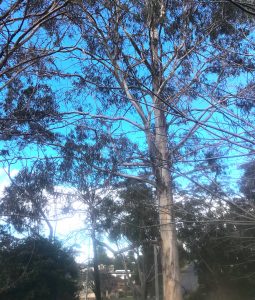When I write “winter in the Blue Mountains”, what do you think of? How do you imagine it? Cold and misty? Maybe some frost or left-over snow on the ground? Perhaps it’s windy, with those heavy green-grey clouds that suggest it’s about to start snowing? Or did you imagine drizzling rain, and a mug of hot chocolate in front of the open fire?
Think again. Here is the view from the front deck of my house, at 2pm in the very middle of winter. Clear sky, soft clouds, gentle breeze, warm sun. Beautiful.

What’s my point? My point is that sometimes when we write, we write the version of a scene, or a place, or a situation, that is closer to what we think it should be, rather than what it is. Beaches aren’t always sunny. Cityscapes aren’t always gritty and grimy. Parks aren’t always lush and green. Often, when young writers (and older writers as well) describe, say, a character who is homeless, they will talk about bare feet and rags. Yes, there are homeless people who fit that bill, but more often they will be wearing clothes that are in one piece, but just a bit old, and a bit grubby. Maybe the clothes don’t fit too well. And bare feet? Most homeless people, in Australia at least, wear shoes. Thongs at the very least. What sort of shoes are they? Old, grimy sneakers, perhaps. Or ugg boots, trodden down on the inside edge of the heels. Cheap KMart joggers.
What we’re talking about is cliché, of course, and cliché is the enemy of good writing. The nerdy kid who wears glasses and has a bowl cut, the detective in the overcoat, the artist in a turtle-neck sweater. All clichés.
Now, some clichés are real. Some winter days in the Mountains are exactly how I described them above. But not every one is, and sometimes it’s good to surprise the reader with a description that is a little more realistic and, at the same time, unexpected.
JR

0 Comments